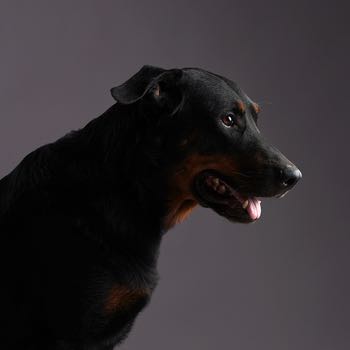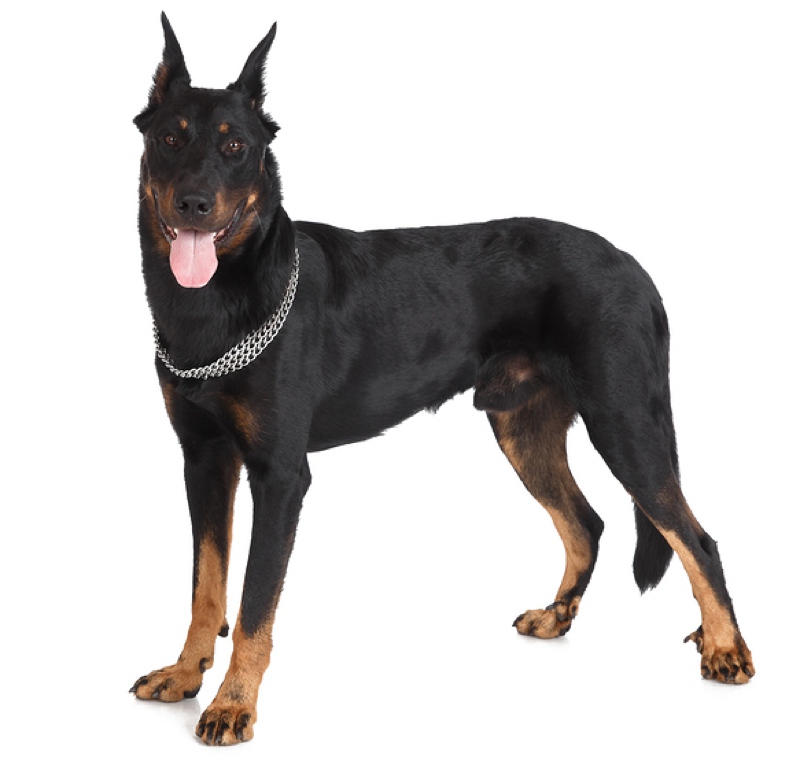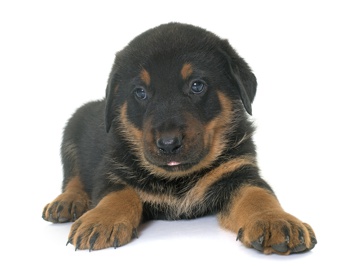Beauceron

The Beauceron is a large, athletic breed with a long history that is nevertheless relatively unknown in much of the world. Hailing from northern France, it has been used for centuries as a guard and herding dog, as well as in the establishment of some other well-known pedigrees. Beaucerons are extremely intelligent and responsive, and in the hands of a committed owner, capable of being trained to a very high level. Their natural suspicion of strangers, combined with their loyalty and courage, means they make excellent family guardians. However, they should always be supervised when with small children, as they are also strong-willed and may resent the relentless attention of the very young.
Beaucerons are most at home in a pack consisting only of humans; they have a low tolerance for other dogs, especially those of the same sex, and they are likely to view smaller pets as prey. Their high intelligence and working background means they must be kept mentally and physically stimulated – many are still employed on French farms and in the emergency services – so owners must be prepared to devote plenty of time to exercise. Although there are several inherited health conditions of concern, this is a remarkably healthy breed, having not been extensively and irresponsibly bred, and its average life expectancy is 11 to 13 years.
About & History
The breed is variously known as the French Shepherd, Berger de Beauce, and Bas Rouge (meaning red stockings). Its earliest mention was in a manuscript dating back to 1578, which described a working dog of the northern region of France closely fitting the description of the modern breed. Despite the dramatic difference in their superficial appearance, it is very closely related to the Briard; in fact, the two fell under the same standard until 1863, when a Monsieur Pierre Megnin, Professor of Zoology at the School of Veterinary Medicine in Vincennes, distinguished between the long-haired Berger de Brie, and the shorter-haired Berger de Beauce. By the end of the nineteenth century, the dog we now know as the Beauceron was very much standardised, and the large number of entrants in the French dog shows of the time were scarcely different to those we see today. Along with other breeds, including the Rottweiler, German Pinscher, and Weimaraner, it was used to establish the Doberman Pinscher breed in the early twentieth century.
The main functions of the Beauceron have always been to herd and protect flocks of sheep and herds of cattle. Although the demise of the wolf in France means that protection is less often required, it retains a very strong guardian instinct that can be seen in defence of its owner or territory. Needing to be both independent in its guardian duties and responsive to the shepherd’s commands, it was bred for high intelligence, and it is a breed that has a strong drive to work and to be kept busy. Over the past century, it has found new employment in various roles, from acting as a messenger and mine-detecting dog in the two World Wars, to police and protection duties, to search and rescue.
Appearance

The Beauceron is an imposing, large dog, solidly built without being lumbersome. It is very well-proportioned, athletic and lithe, with an upright and noble carriage and an air of assuredness and steadiness. Its head is chiselled, with its flat skull and the top of the muzzle running in parallel, and both of equal length. The occipital prominence at the back of the head is quite evident, while the stop is subtle. The jaw is strong, with a perfect scissor bite of large teeth. The eyes are intelligent and alert, slightly oval in shape, of varying shades of brown. While the short ears were traditionally cropped, they should be set high on the head and held either semi-erect or dropped.
The neck is reasonably long – again, in proportion to the large head, and is well set on with a broad muscular base at the shoulders, while the back is straight and level, leading to only a very slight slope at the croup. The tail is generally carried quite low in a J-shaped curve. The breed’s athleticism is reflected in its broad nostrils and wide, long chest that is let down to the point of the shoulders. The limbs are quite upright when viewed from all angles, and the hindlimbs in particular are heavily muscled, being widely spaced apart when viewed from behind. The paws are large and compact, with well-sprung toes.
Although the coat is short, it is dense, hard, and weather-resistant, with slight fringing around the base of the tail. If examined closely, the undercoat can be seen to be a soft, dense tangle of fine grey hairs, but this is ordinarily hidden by the outer coat, with can be either black and tan or harlequin. It is the black and tan variety that is the more common, and which has the squirrel-red stockings alluded to by the Bas Rouge moniker by which the breed is sometimes known. The harlequin variety has a mottled coat of grey and black (which combine to appear blue) with tan markings.
The two sexes are distinctly different, with the males being noticeably heavier, and the females more refined and feminine. The height range is 65 to 70 cm (26–28 in) for males, and 61 to 68 cm (24–27 in) for females, and their respective weight ranges are 40–50 kg and 32–42 kg.
Character & Temperament
The Beauceron is an extremely intelligent, gentle, and obedient dog in the hands of its owners. It has a generally calm demeanour, but is suspicious of strangers, and will adopt a protective attitude if it feels its family is threatened. As a guard dog, it does an excellent job of raising the alarm, and will follow through with force should the situation demand it – a trait that does need to be managed with intensive socialisation.
It can be strong-willed, and needs an experienced owner to lead the way, as it has the potential to dominate people who are unable to frame themselves as credible pack leaders. This breed does not mix well with other pets, including dogs.
Trainability

Beaucerons are highly trainable, intelligent dogs that both want and need constant stimulation. They are eager to please, and extremely responsive to praise from a strong pack leader. Training should begin at a very young age, and good manners, such as sitting when waiting for food, and not jumping up without invitation, should be taught from when the pup is 8-weeks-old.
Because of their natural wariness of strangers, Beaucerons must be intensively socialised with people outside the family – this should be started as soon as a puppy is acquired, and continue throughout life. For those with the time to commit, and the inclination, this is a dog that will excel at obedience, agility, and flyball competitions.
Health
Most Beaucerons are extremely healthy; however, like any breed, there are a number of health concerns that prospective owners should be aware of:
Atopic Dermatitis
Skin allergies caused by contact with, or inhalation of, environmental allergens.
Congenital Deafness
Although not a common complaint, some Beauceron puppies are born deaf. While this may not be noticeable at the time of choosing the pup (something that is often done in the first couple of weeks of life, or even before birth), signs should be evident to the breeder by around 6 weeks of age, when affected pups become noticeably less responsive to sound than their litter-mates.
Dilated Cardiomyopathy
A form of heart disease seen in large-breed dogs as the result of weakening and stretching of the heart’s muscular walls. Signs such as abdominal swelling, shortness of breath, and coughing are amongst the first indicators of the condition.
Elbow Dysplasia
Inherited developmental deformity of one or both elbow joints, causing signs of lameness in growing dogs. Parents should be “scored” through x-ray examination to ensure breeders only use those dogs with healthy joints.
Gastric Dilatation / Volvulus
Like other breeds with a deep chest, the Beauceron can suffer a torsion of the stomach that can lead to rapid abdominal bloating and signs of severe distress. Best prevented by feeding several smaller feeds throughout the day and avoiding exercise immediately after eating.
Hip Dysplasia
It is estimated that around one in seven Beaucerons are affected by this inherited cause of hindlimb lameness. Like elbow dysplasia, breeding stock can be screened by x-ray, and anyone considering the purchase of a pup should insist on seeing the parents’ hip scores.
Exercise and Activity Levels
This is a breed designed to be on the go at all times, and has a great capacity to exercise. It is an ideal companion for avid hikers or long-distance runners, and should be given a minimum of an hour of lead walking every day. Many Beaucerons will also enjoy swimming, and those partaking in canine sports will benefit from both mental and physical workout this provides.
Grooming
As one might expect from a working breed, the Beauceron has an easily managed coat that requires just weekly brushing to remove loose clumps of hair. However, it does shed heavily, especially in the spring and autumn. Baths are seldom necessary, unless the dog has found something unpleasant to roll in.
The dark nails are thick and hard-wearing, and need occasional clipping. This is something that can be done at home, but with care, as it is usually impossible to see the pink blood vessel running down the centre of each nail.
Famous Beaucerons
Despite its low numbers outside France, the breed has been reasonably popular on stage and screen, presumably by virtue of its trainability. The following are some of the better-known movies in which it has appeared:
- Hotel for Dogs featured a Beauceron named Henry
- In the film, Marmaduke, an adaptation of Brad Anderson's comic strip, the main antagonist is a Beauceron called Bosco
- Moonraker, the 11th film in the James Bond spy film series, exposed the masses to the breed for the first time in 1979
- In the 1970 French film, The Wild Child, or L'Enfant sauvage, there is a Beauceron among the pack of hunting dogs used to track down the feral child in the lead role
Cross-Breeds
Beauceron-cross hybrids are not easy to come by, but the most common ones available are the following:
- Beaucador – Cross between a Beauceron and a Labrador Retriever
- Beauceroodle – Cross between a Beauceron and a Poodle

